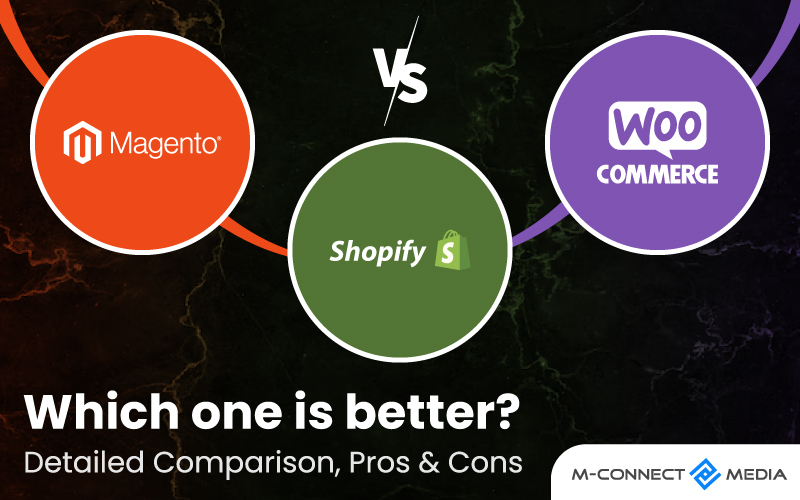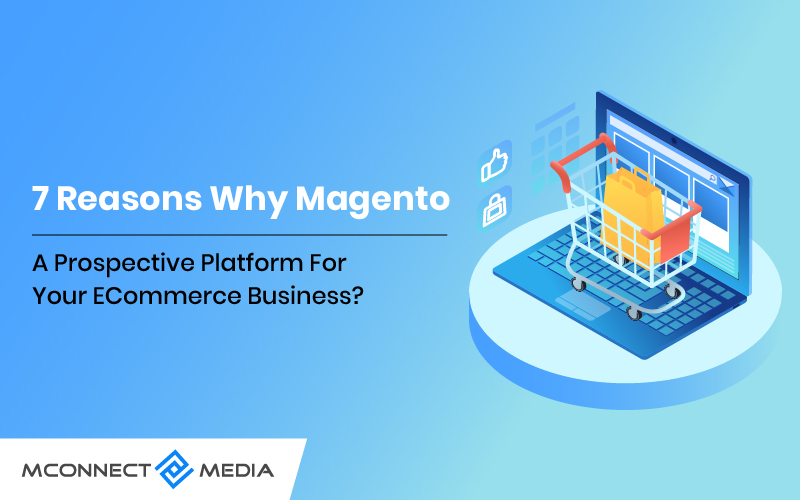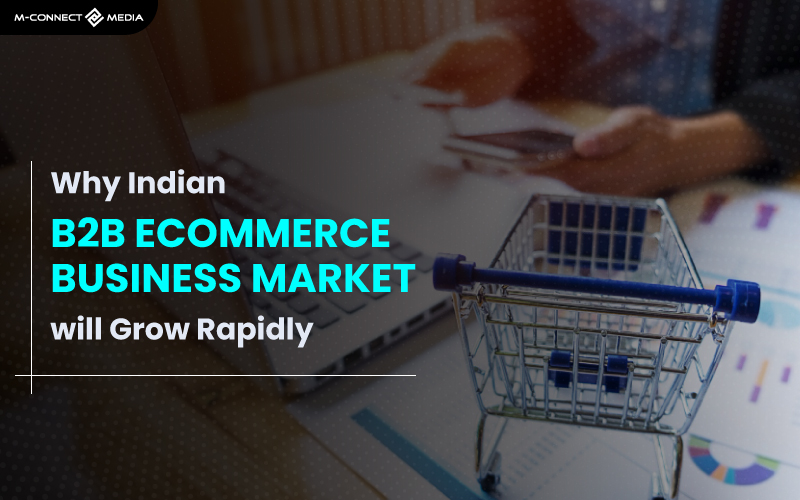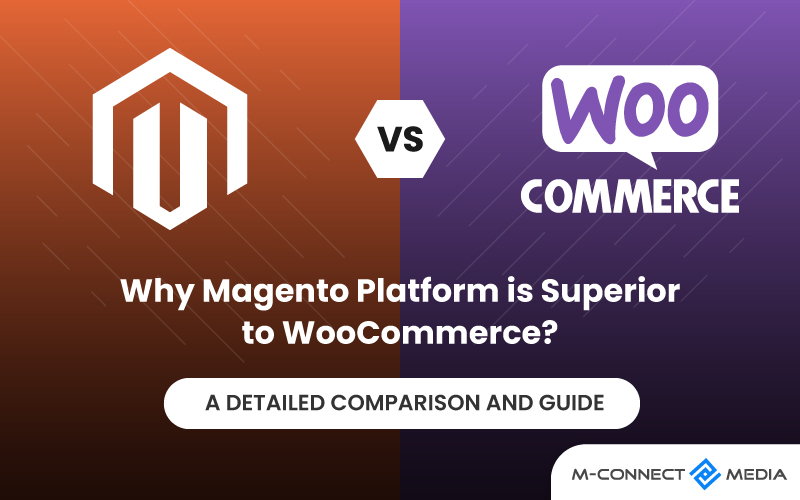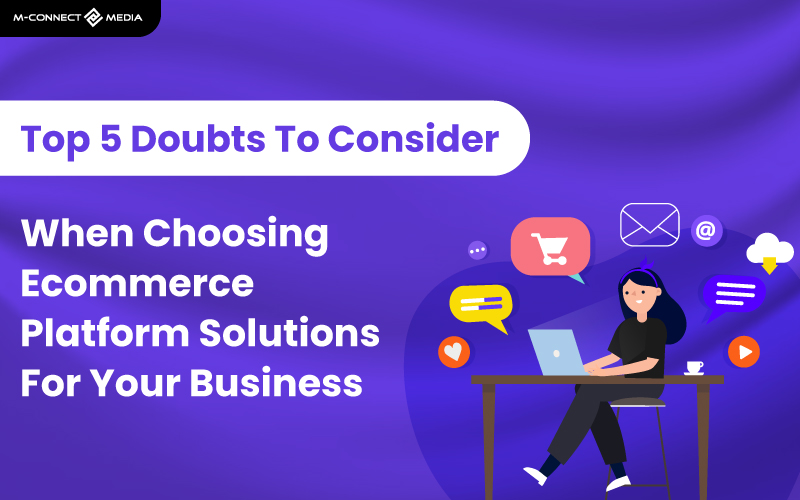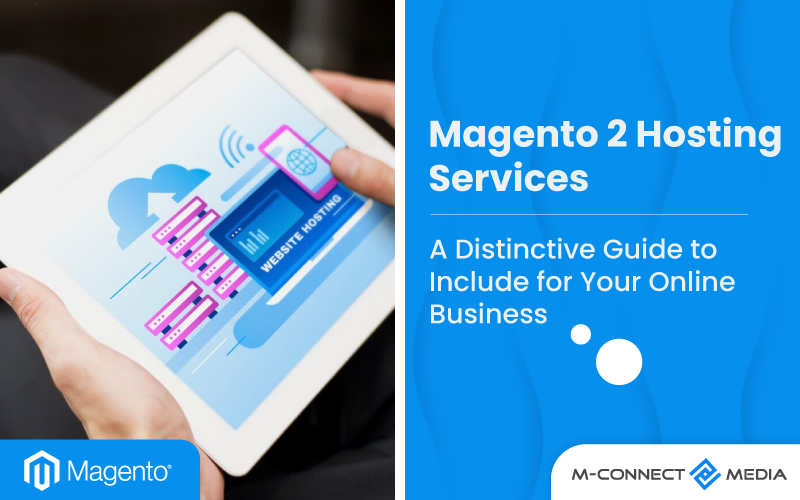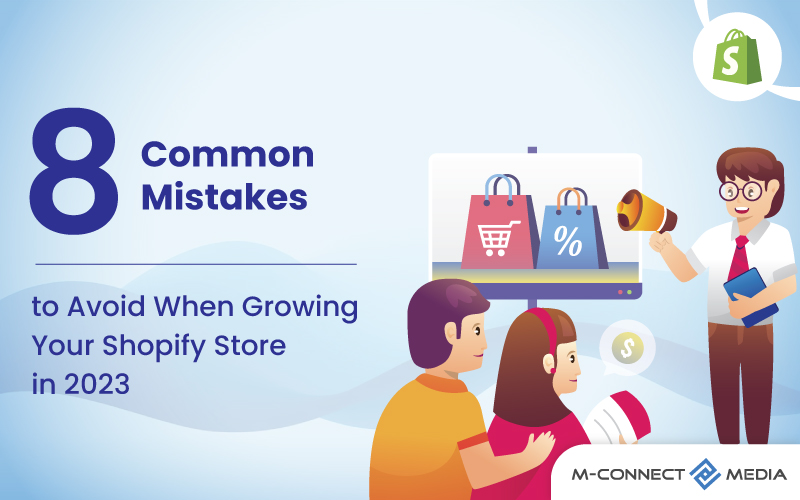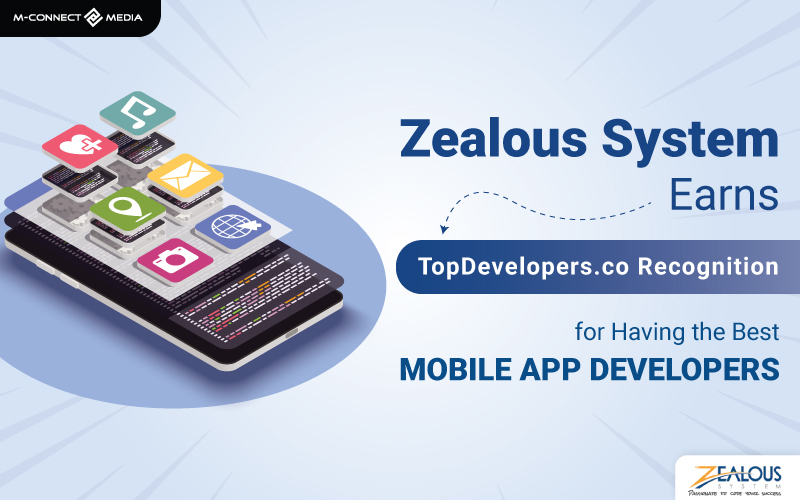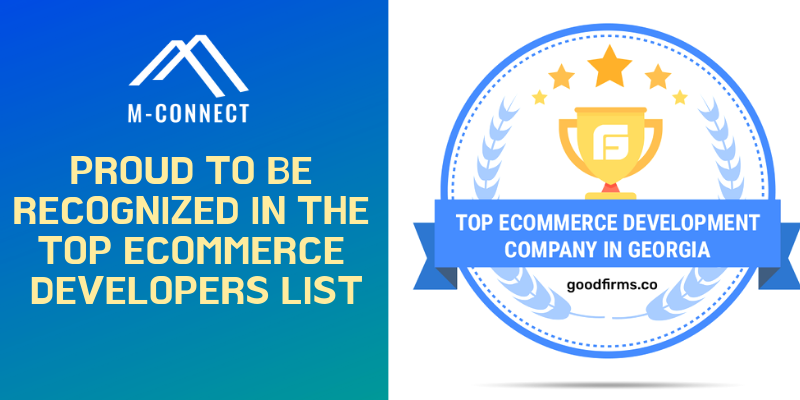When it comes to creating an online store, three options are among the top choices: Magento, Shopify, and WooCommerce. But how do you decide which one is better for your online business when you’re trying to compare before Magento Vs Shopify Vs WooCommerce?
No platform is ever flawless. They come with a unique set of features and limitations. The key is to ensure that the platform you choose has everything you require. Moreover, Selecting the best eCommerce platform for your needs is crucial for success as a business owner.
Choosing the best Ecommerce platform for building, managing, and maintaining an online store is crucial. However, It could be deciding factor in whether business thrives or falters in the long run, which is important for small enterprises with limited funds and resources.
We can help you select the right eCommerce platform for your business! In the battle of the best, choosing can be tough, which is why Mconnect Media has put together a comparison guide for Magento, Shopify, and WooCommerce.
Today’s article will give you a comparison of Magento, Shopify, and WooCommerce to assist you in making the best choice. Before stepping into the eCommerce market, it’s also crucial to examine the pros and cons of each platform. So, let’s dive in!”
Magento, Shopify, and WooCommerce – An Overview
Magento – At A Glance
Adobe Commerce or Magento is an open-source Ecommerce platform that was founded in 2008 in Culver City, California, by Roy Rubin and Yoav Kutner and is currently under Adobe’s ownership. It’s widely used, powering over 700,000 websites around the world.
Big companies like Olympus, Cox & Cox, and Vizio are considering using Magento 2. Magento open source comes with several built-in features, including quick language and currency adjustments, extensive report generation, and product discounts.
Magento comes with a wide range of built-in features. You can easily switch between languages and currencies, create coupons, generate detailed reports, offer discounts on specific products or to returning customers, and much more.
Moreover, Magento Open Source provides an extensive library of plugins and templates. You can also customize the HTML or PHP code to add unique features to your store.
Magento is a robust platform that works best for larger businesses with the means to hire developers to create a tailored platform for their business and products. It also excels at handling vast amounts of product data and offers great scalability for e-commerce.
Also Read: Must Consider Magento 2.4.6 Release Notes Before Migration – Key Features
Quick Facts Before Consideration Magento Platform
Creating a Magento Ecommerce website has its advantages for both small businesses and established company models, but it’s also more complex and expensive compared to other Ecommerce web development platforms.
If you’re not a developer, Magento might not be the best choice for you because it requires some customization. There are only five themes available on the Magento Marketplace, three of which are free, and the other two are premium.
Moreover, Magento lacks point-of-sale (POS) functionality, which can also make it more challenging to develop a business in this area if you’re not comfortable with coding.
Even if you want to use Magento, you can also consult with a professional Magento website or store development company to determine the best solution for your organization.
Pros & Cons of Magento
Pros
- Maximum Scalability
- Built-in features
- High adaptability and customizability
- Omni channel support
- Broad Supportive community
- Advanced Testing Capabilities
- Large user and developer base
- No coding skills required
- Several themes and Extensions
Cons
- Expensive to build and customize.
- Require technical expertise
- Setup process can take a while
- Limited Product Support
- Various associated Costs
- Suitable for Only Dedicated Server
Also Read: Important Things You Should Know Before Upgrading Magento 2 Version
Shopify – At A Glance
Shopify is a Canadian eCommerce platform founded in 2004 by Tobias Lütke and Scott Lake. However, Shopify is web software designed for creating your own online store. In 2006, it became one of the year’s most successful businesses.
As of 2023, there are over 6,312,392 Shopify Plus Stores online, with more than 1,000,000 businesses in 175+ countries. It’s a popular choice for businesses looking to sell products and services online and reach a global customer base.
Shopify is a top choice for building eCommerce websites because it allows you to set up an online shop in just 15 minutes. It also offers a variety of customizable ‘themes’ to match your branding needs, and it supports the sale of both physical and digital products.
Shopify offer subscription-based monthly plans for online business storefronts, starting at $29/month for the Basic Shopify Plan, $79/month for the Standard Shopify Plan, $299/month for the Advanced Shopify Plan, and $2,000/month for the Shopify Plus Plan.”
With Shopify, you don’t have to worry about hosting services. Getting a custom domain is a simple three-step process. Plus, you also get benefits like unlimited product creation, unlimited file storage, discount coupons, two admin accounts, 24/7 support, and more.
Know More: How to Launch Shopify Website and Go Live: Stepwise Detailed Guide
Quick Facts Before Consideration Shopify Platform
Shopify is well-known for its user-friendly interface, which makes it ideal for novices and individuals with less technical skills.
Shopify also offers a large app store, some key functions may need the use of third-party applications, which might increase your costs.
While Shopify has a variety of price levels, it’s important to consider membership fees, transaction fees, and any additional app charges.
Shopify enables for customization, the degree of design flexibility may be limited in comparison to platforms like WooCommerce or Magento.
Shopify offers customer support, but response times might differ depending on your plan. Think about how quickly you might need help.
Pros & Cons of Shopify
Pros
- Easy for store setup
- User-friendly interface
- Integration with social networks and WordPress blogs
- Easy to purchase a custom domain name
- Multiple free and premium WooCommerce themes
- Excellent design options and flexibility
- Numerous payment choices
- Third-party app support
- 24/7 availability and support
Cons
- Payment Processing and Higher transaction fees
- Need Optimal URL structure for SEO
- No access for Automated Marketing
- Not user-friendly as Alternative Platforms
- Lacks sufficient built-in features
Also Read: Shopify Guide: How to Develop Product Development Strategy That Work
WooCommerce – At A Glance
WooCommerce is a free and open-source eCommerce plugin for WordPress. Moreover, WooCommerce was established in 2011 by three visionaries: Adii Pienaar, Magnus Jepson, and Mark Forrester. Over 6.3 million WordPress websites use WooCommerce plugin globally.
The WooCommerce plugin provides free way to connect with a WordPress site and manage a store. It takes 10-20 minutes to set up a WooCommerce online Store. You can also customize how your store looks and add commercial extensions to make website do more.
Using WooCommerce, You can sell all things, like physical products, digital downloads, or products from affiliate links. It also comes with helpful features, like shopping cart, geolocation support, a design that works on all devices, and tools to help you figure out shipping and taxes.
If you wish to add some extra functionality, WooCommerce has 770+ free and paid extensions. WooCommerce is adaptable and familiar to any WordPress website, there are over 30,000 free and paid themes available for setting up an online store.
With WooCommerce, You can also use premium WooCommerce plugins to add more cool stuff to store, like product comparison tools, quick browsing options, pop-up notifications, different ways for customers to pay, and special ways to feature products.
Quick Facts Before Consideration WooCommerce Platform
WooCommerce site takes just one second longer to load, you might lose 7% of potential customers. So, speedy sites are super important!
Some technical things to consider about when setting up WooCommerce store. Like Ensuring images load fast, having a good website address structure, and keeping technical stuff up to date.
While WooCommerce itself is free, you may need to pay for hosting, domain registration, and premium plugins.
If those concepts are unfamiliar to you, speak with a WooCommerce development provider about your company needs.
Also Read: Why Magento is 10x better than WooCommerce? In depth Comparison
Pros & Cons of WooCommerce
Pros
- Open source and Free
- Free Installation
- Customize with Extensions
- Configurable themes and site designs
- Advanced functionalities
- Gateways for payments
- Customers and store admin support
- Free and premium themes available
Cons
- Additional Expenses
- Coding Knowledge
- Extension Cost
- Browsing Speed
- Customer Service and Support
- Not Ideal for Smaller Businesses
Magento Vs Shopify Vs WooCommerce: Detailed Comparison
1. Ease of Use
Magento, while also an eCommerce web development platform, is better suited for Experienced Magento 2 developers with significant Magento knowledge due to its setup, development, and customization requirements.
Shopify is extremely easy to use. Four out of five Shopify testers find it to be the most user-friendly eCommerce development platform. To create a fully working online store with Shopify, you don’t need any website development experience.
On the other hand, WooCommerce, being a WordPress plugin and not a builder, relies on the theme builder used for the WordPress website. However, If you’re not a coding expert, it may not be easy!
2. Performance and Scalability
Magento 2 comes with several speed and scalability upgrades, including optimized web pages for faster loading, improved server response times for all website activities, and enhanced database flexibility and scalability to handle peak demands while improving the efficiency of backend operations.
Shopify plan is great for small to medium-sized businesses. However, if your sales are growing rapidly, Shopify Plus is an excellent option because it can handle more visitors and sales than the standard Shopify platform. It also offers integration with LaunchPad automation technology.
WooCommerce allows for scalability, but users without advanced technical skills may find it challenging to expand their online stores to meet their requirements. Its analytics can also effectively handle products, high traffic, sales volume, and inventory.
3. Design and Customization
Magento platform comes with two default themes: one acts as blank canvas for creating Magento 2 custom themes and another Luma, which serves as a demonstration theme. Since it is an open-source platform, you have the option to build and incorporate a custom Magento template.
One of Shopify’s standout features is its high-quality themes, which are a strong selling point. Users can easily browse and apply these themes to enhance online stores. Shopify’s customization options are somewhat limited due to its proprietary codebase.
WooCommerce users enjoy customization capabilities. They can customize and code plugins, themes, and extensions to enhance and functionality of website. You can personalize elements like WooCommerce product gallery, store page, website header to make site attractive.
Also Read: Benefits of Using Responsive Magento 2 Theme Design For Your Store
4. SEO Functionality
Magento is often considered the most powerful eCommerce solution for SEO. It offers excellent features and extensions to businesses to enhance SERP ranking. It has features like no-follow links, Google sitemaps, redirects, and canonical tags. Magento also allows users to freely customize store’s appearance and SEO capabilities.
Shopify provides a basic set of SEO features to assist in enhancing store’s content for better SERP rankings. This includes the ability to modify meta tags, add alt text to images, create 301 redirects, and generate an auto XML sitemap, among other things. The platform also offers SSL certificates for secure checkout and content hosting.
WooCommerce, as a WordPress plugin, has access to all of WordPress’ SEO features. It enables you to update content, create new content, and add meta information to ensure that your product keywords rank well on search engine results pages (SERPs).
5. Security
Magento can make its stores extremely secure. It provides store owners with enhanced security through regular specialized security updates. Additionally, it offers a range of built-in security features to help protect Magento installations and maintenance.
When it comes to security, using a hosted eCommerce solution like Shopify is less risky than setting up a shop using open-source platforms. Shopify takes care of all the security measures in the background, so you don’t have to do anything.
WooCommerce website is built on the WordPress CMS, the security level is similar to that of the WordPress environment. Therefore, it’s essential for WooCommerce shop to follow best practices in choosing secure website hosting and packages.
6. Extensions and Apps
Magento is known for having most extensive marketplaces among eCommerce platforms. With about 6,000 free and paid extensions, Magento offers a wide range of options to enhance and expand store’s functionality. You can find Magento 2 Extensions for accounting and finance, content personalization, and customer service, among others.
Shopify can handle many add-ons simultaneously, with over 8,000 apps available. However, it’s a good practice to install a reasonable number, such as 30 apps, at a time. These add-ons helping you boost sales, add trust badges, and incorporate social buttons to expand your customer base.
WooCommerce was constructed using the WordPress platform, which means users have access to over 56,000 WordPress plugins. These extensions can be employed to tailor your site to suit business requirements. You have options for payment gateways, SEO, lead generation, marketing, navigation, and usability enhancements.
7. Customer Support and Service
Magento 2 support depends on the software version you’re using. It comes in two versions: Magento Open Source and Magento Commerce. Magento Community has limited support, and users rely on Magento forums and communities for assistance. In contrast, Enterprise users receive official full-service support, including email and live chat.
Shopify is a fully hosted platform, they offer support through live chat, phone, email, and Twitter seven days a week. In addition, Shopify provides documentation, how-to guides, a knowledge base, video tutorials, and forums for users. Their support team delivers valuable assistance with information and quick response times.
WooCommerce doesn’t provide direct assistance because its product is free. This doesn’t mean you can’t address issues with a bit of research. WooCommerce offers a helpful documentation page and email support for specific inquiries. They may not have same level of support as other store builders, they still assist with problems.
8. Pricing Plans
Magento has following pricing Plans available:
- Web hosting costs between $14.99 and $39.99 each month.
- Domain registration costs between $10 and $20 each year.
- SSL certificates cost between $50 and $600 per year.
- Payment platforms and credit card processing fees range from 2% to 4% each transaction.
Shopify has following pricing Plans available:
- Shopify Starter costs $5 per month plus 5% and 30 cents each transaction.
- Basic costs $39 per month plus 2.9% and 30 cents every transaction.
- Shopify costs $105 per month plus 2.6% and $30 each transaction.
- Advanced Shopify costs $399 per month plus 2.4% and 30 cents every transaction.
- Shopify Plus costs $2,000 per month plus transaction fees.
WooCommerce has following pricing Plans available:
- Dedicated Hosting costs from $89.99 to $739.99 per month.
- Cloud hosting costs from $2.99 to $360 per month.
- Shared Hosting costs between $2.95 and $13.95 per month.
- VPS hosting costs from $2 to $110 per month.
- WordPress hosting costs between $2.95 and $16.99 per month.
Also Read: How Do I Set Customer Group Specific Pricing for Magento 2 Customer Groups?
Finally, Which One Is Better Option for Your eCommerce Business?
So, which Ecommerce platform is better for your business or store? However, It all depends on your requirements and budget.
We hope our detailed eCommerce comparison guide helped clear up any confusion. However, we understand that each organization has its unique needs.
Shopify is an excellent solution if you need a user-friendly platform with lots of functionality. Moreover, it is the best platform for small businesses looking to expand their online presence.
Magento is a great alternative if you’re on a tight budget and need a flexible platform with customization possibilities. Moreover, it is the finest choice for large corporations with extensive resources.
WooCommerce is also a great option if you have a WordPress website and want to add an online store. Moreover, it can effectively empower small and medium-sized businesses.
If you’d like to share your thoughts or experiences with any of these three products, please leave a comment or contact us for more information.
Frequently Asked Questions:
- Which is better WooCommerce or Magento?
The ease of use of an ecommerce platform is crucial to consider, especially if you are a newbie. WooCommerce came out on top in this category. Moreover, Magento is intended for developers with technical competence. As a result, it cannot be simple for frequent consumers.
- Which one is better Magento or Shopify?
Shopify is more user-friendly than Magento. Magento is more versatile than Shopify in that you can personalize your site with code although it is also considerably tougher to use overall, making it difficult for most users to establish a store to be proud of.
- Which is better WooCommerce or Shopify?
WooCommerce and Shopify are both excellent platforms for running a dropshipping business. WooCommerce has a little advantage due to its simplicity of use and a large number of plugins, making it very adaptable. Moreover, Shopify does provide certain customization choices, they are likely to be more limited.
Related Recent Posts:
- BigCommerce Vs Magento 2: Which Ecommerce Platform Is Better For You in 2023?
- Shopify Vs Shopify Plus: Which Shopify Version Is Better for Your Business in 2023?
- Magento Vs Shopify – Which Ecommerce Platform You Should Prefer?


